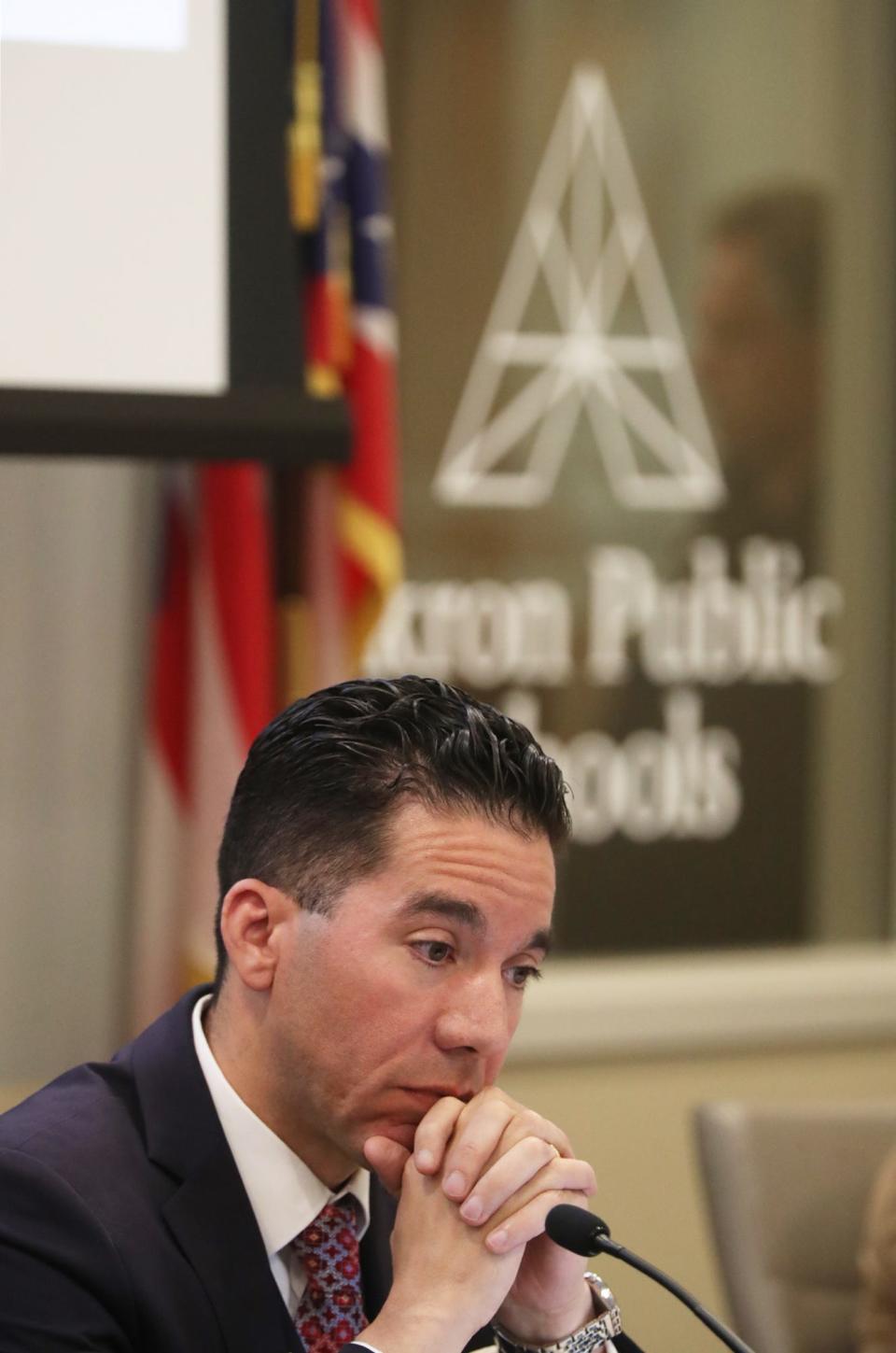Promises kept? Akron school board questions I Promise School's poor test scores
This fall's class of eighth graders at the I Promise School hasn't had a single student pass the state's math test since the group was in the third grade.
"Not one? In three years?" Akron Public Schools board member Valerie McKitrick asked after that data point was presented to the board earlier this week.
"It is discouraging," responded Keith Liechty-Clifford, the district's director of school improvement.
Five years into the I Promise School, a public school that operates in partnership with the LeBron James Family Foundation, Akron school board members are starting to ask questions about whether I Promise is living up to its academic promise.
The goal of the school is to serve as an intervention for the district's lowest-performing students starting at an early age. It is a rare — if not unprecedented — model in education nationwide.
But Monday night, the board dug into some of the academic data from the school in its first five years and voiced concern the effort has not yet seen the results that they had all hoped.
The state has also issued its first concern about the school: Two of I Promise's biggest subgroups of students, Black students and those with disabilities, are now testing in the bottom 5% in the state, landing the school on the Ohio Department of Education's list of those requiring targeted intervention.
Board President Derrick Hall, who noted Monday's presentation was the first such overview he had seen on the school in his nearly four years on the board, said he was disappointed with the data, even with COVID-19 and a year of remote learning as known factors, given the plethora of additional resources at the school.
"For me as a board member, I just think about all the resources that we're providing," Hall said. "And I just, I'm just disappointed that I don't think, it doesn't appear like we're seeing the kind of change that we would expect to see."

Additional dollars add teachers, tutors, wraparound services
The school receives the same local, state and federal funding as any other public school. But on top of that, the foundation has given up to $1.4 million each year for additional tutors and more teachers in younger grades to lower class sizes.
The foundation also partners with other organizations to provide significant wraparound services and support for students, from job training and high school equivalency courses for parents to housing for students' entire families if needed. The onsite Family Resource Center, staffed by the foundation, has been so successful at connecting with families the model has now been replicated at other Akron schools through partnerships with the United Way of Summit and Medina Counties.
In a statement following Monday's meeting, the foundation said it was committed to the work.
"When we started this work to wraparound students through education, we entered this partnership with Akron Public School for the long haul," the statement said. "Because this work requires a long-term commitment, hard work, and a lot of love and care. And that's what we bring each and every day because the I Promise School is more than a school. We're here for the ups and downs, and will continue to wraparound our students and their entire families so they can be successful in school and in life, no matter the challenges and obstacles that come their way."
The school enrolls students in third grade through a lottery. Students are entered into the lottery if they are in the bottom 25% of reading scores in the district. Students with significant disabilities who are already served in other specialty programs are removed from the lottery. If their child is picked in the lottery, parents receive an invitation to enroll their student in the school, or they can stay at their current building.
But comparing I Promise students to their peers who qualified for the school but attend elsewhere shows that I Promise students are doing worse in some cases, despite the extra staff and wraparound services.
Most recent I Promise state test data revealed
Liechty-Clifford, who was previously the district's liaison to the school, presented data that showed some grades of students at I Promise have improved year over year based on state test results, while others went backward.
Last year's fifth grade class has double the number of students proficient in reading from when they were in fourth grade, from just under 6% to 13% of the class.
But last year's sixth graders lost ground. When they were in fifth grade, 7% were proficient on the reading test. In sixth grade, just 2% were.
Students come into the school an average of two years behind, so it's not surprising that in early years, students wouldn't be able to make up that much ground in just a year or two. The goal of the school was to have students grow about a year and third each school year, so by eighth grade, they would be caught up and ready for high school.
But when school's first class of eighth graders graduated from I Promise, just 11% of them tested proficient on the state English language arts test.
The incoming group of eighth graders, the ones who haven't tested proficient on the math test in three years, weren't always struggling at that level. Their first year in the school, when they were in the third grade, 17% of the class tested proficient in math. The following year, there were no tests because of COVID, and ever since, they have not had one student pass the test. On the English test this spring, 8% of them tested proficient.
The district did not provide comparable state test results for the control group of students who met the criteria for I Promise School but didn't attend.
But Liechty-Clifford did show the comparison of how I Promise students performed compared to their peers on internal testing, a district assessment system known as iReady. On iReady this year, I Promise students in grades 3-8 performed a combined two points better in reading, but six points worse in math than those who were also in the bottom 25% going into third grade but are enrolled elsewhere in the district.
Liechty-Clifford said they knew from the time they opened the school that the work would be hard. The same issues that plague the I Promise School plague many urban schools.
"If I could take kids who are two and three years behind, and get them on level in one year, I'd probably resign and take my show on the road," Liechty-Clifford said.
The school takes in the district's most vulnerable students, many of whom have endured significant traumas in their lives or have learning disabilities. The school also lost its founding leader during its third year, and then had three interim principals in a year and a half. The school named a new permanent principal last school year, but she left the district at the end of the year.
Liechty-Clifford also noted, when the pandemic hit, I Promise was just a year and a half old, still establishing its culture, while also onboarding 10 new teachers and 120 more students during remote learning.
At the same time, he said, "I don't want to use the pandemic as a crutch."
State designation highlights the achievement gaps
The Ohio Department of Education recently designated the I Promise School as an Additional Targeted Support and Improvement (ATSI) School, meaning its students in certain subgroups are low performing on state tests.
Black students at I Promise are testing in the bottom 5% of all Black students in the state. The same is true for students with disabilities.
At I Promise, Black students make up about 60% of the school. About 28% of the school's 555 students have a disability.
In an adjustment made last year, the district caps the number of incoming students who have any known disability at 10% of the 120 students chosen for the school.
The number of students with disabilities was climbing, and teachers were becoming overwhelmed trying to meet every student's need.
In the rising sixth grade class, half the student population has a disability, according to Monday night's presentation.
Two years ago, 10 teachers resigned from the school, tied for most in the district. Last year, five teachers left.
Akron Education Association President Pat Shipe, who was present for the presentation, said afterward, "I think that the red flags that are being thrown up about the IPS are concerning.
"I think there have to be much deeper conversations and more data looked at before we can really address some of the issues that we're seeing," she said.
Looking forward with a new principal
The district has assigned Stephanie Davis, who previously served as the principal of Bridges Learning Center, to be the new I Promise principal this fall.
In the statement sent following Monday's meeting, the foundation said Davis is the "perfect person" to move the school forward.
"We're incredibly excited about the upcoming school year and a return to consistency under the leadership of Principal Stephanie Davis, who is the perfect person to lead the I Promise School and all of our families to the success we know they will achieve. Because we will do it together, as a family."
Davis, in a statement also sent by the foundation, said data that wasn't provided Monday night shows students are still growing, even if they aren't quite yet on grade level, based on their iReady scores, with 42% of them growing at least a year's worth in the last year in math and 4% of them reaching a "stretch" goal beyond that. In English, 32% met a goal for typical annual growth, with 11% exceeding that.

"One of the things I’m most excited about coming into the I Promise School is the optimism and energy around getting our students to a level of achievement we know they’re capable of," Davis said. "At the recent board meeting, our preliminary (state testing) data was shared, but it’s important to note that proficiency is based on mastering grade-level standards."
When looking at students who are starting from behind, she said, growth is an important measurement of success as well as proficiency.
"And the type of growth that is important to us is not made overnight," she said. "It takes time."
Hall said Monday he was not making any summative statements about whether the school was working or not, but that it was necessary to ask questions to understand how the school is doing and what is going to change in the future based on the data.
If he were the foundation, Hall said, he would want to know the return on its investment.
"The foundation's not here to educate our kids," Hall said. "That's our job."
Contact education reporter Jennifer Pignolet at jpignolet@thebeaconjournal.com, at 330-996-3216 or on Twitter @JenPignolet.
This article originally appeared on Akron Beacon Journal: I Promise School's poor test scores prompt questions from Akron board

